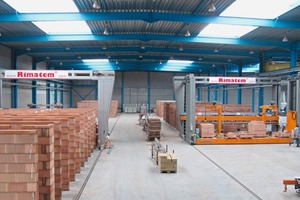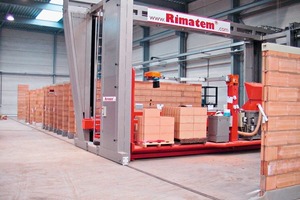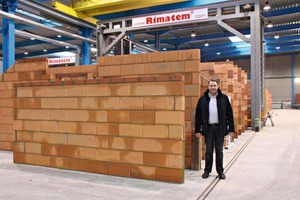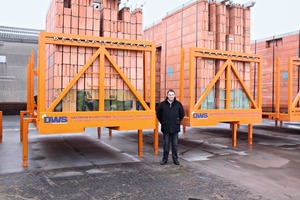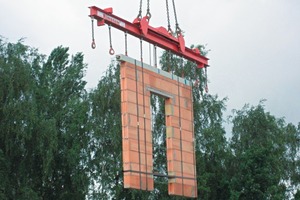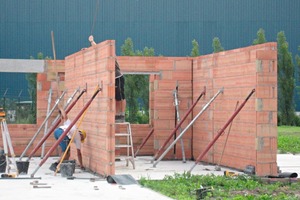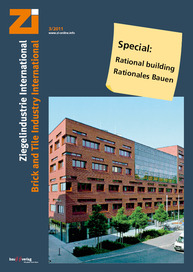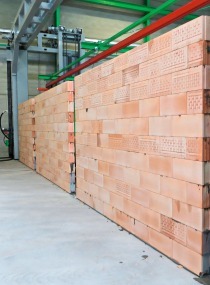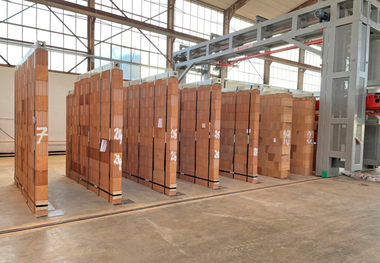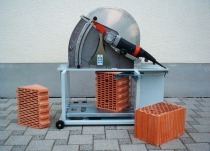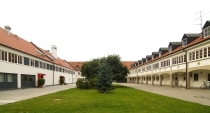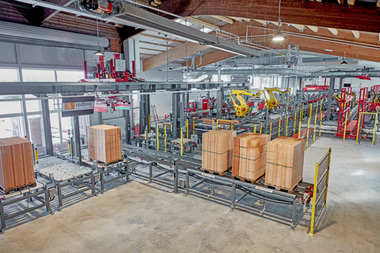The family-owned and ‑operated enterprise dws-prefab used to be exclusively focused on constructing carcasses for multi-storey and individual residential buildings. The company produced the requisite precast concrete elements in their own, little concrete precasting facility. But in 2005, Managing Director Filip Despierre heard something about a German company called Rimatem and their automated prefab masonry equipment. Production facilities by Rimatem can prefabricate sandlime, concrete, lightweight concrete or clay-brick wall units. As a dynamic, dedicated manager, Despierre became keenly interested in that type of construction, but he was hardly able to believe that this kind of automation is really possible – until he paid a visit to the German company Hüning-Elementbau in Waltrop, where six Rimatem masonry units had already been churning out prefabricated brick walls since 1992. “I was very impressed by the speed of production to be achieved with that sort of equipment”, says Filip Despierre. “But I was still very skeptical. In Germany, everything is governed by DIN 1053-4 – but that is a German standard that is not valid in Belgium. That is why I could not talk myself into purchasing a unit.”
Belgium’s first Rimatem masonry machine
A year later, Filip Despierre discovered that one of their competitors was successfully – and profitably – running a Rimatem machine in Belgium. Despierre therefore inquired about two different Rimatem equipment models: the semi-automatic HA III and the fully automatic VA I. With the semi-automatic version, up to 150 m² individually planned masonry can be produced in 8 hours‘ time, and the fully automatic version can turn out as much as 1000 m² a day. Either way, individual walls measuring up to 12 m x 4 m can be put together with guaranteed dimensional accuracy and, most important: no dependence on weather. Special-purpose accessories can be produced quickly and economically, because the machine operator can directly intervene in the production process whenever necessary. The two systems are mutually compatible, and both can handle (i.e., mortar or cement) bricks and blocks with wall thicknesses ranging from 11.5 to 49 cm.
“I saw numerous challenges coming at us”, Filip Despierre reports, “but I was sure that we would master them all with some help from Rimatem – an internationally active contractor with long years of experience in the field of prefabricated masonry. Ultimately, I was convinced by the numerous detail solutions. Rimatem thought of everything from the planning of an efficient production facility to the transport and installation of the finished walls.” And so, a team from Rimatem got together with the Belgian entrepreneur and planned a new hall for the machines. The new masonry unit was intended to cover the carcass contractor’s in-house prefab masonry requirements. Tobias Riffel, general manager, was able to convince Despierre to make the hall large enough for a second automatic masonry production unit – just in case and at little extra expense. So, while one half of the new hall was used for producing precast concrete elements, the other half was utilized for making masonry. The first unit was commissioned in May of 2007.
From then on, Filip Despierre was able to provide all the prefab masonry the company needed for all its various jobsites, and he was very enthusiastic about all the time saved and the consistently high quality of production. Even public tendering was no longer a problem. Thanks to the new equipment, dws-prefab had lowered its overhead and put itself in a position to carry out more orders with the same number of personnel spending less time at each contract site. And thanks to the high quality of the masonry produced, Filip Despierre started receiving more and more inquiries from other construction contractors wanting to purchase his prefabricated walls. After a while, he began to supply to other contractors (non-competitors, of course), but that soon nearly exceeded his plant‘s capacity. Even a second shift was unable to satisfy all the demand, so after less than two years, the company had a second masonry unit installed. (Remember: ample space had been provided in advance.)
Three in a year
The second unit was scheduled for delivery in October 2009. Since demand was growing faster than expected, though, Filip Despierre ordered a third, even larger unit in the summer of 2009 – before the second machine had even arrived – and had another hall built to put it in. Finally, a fourth machine was put on order shortly before Christmas 2009.
Rimatem‘s masonry units gave Filip Despierre a second leg to stand on and made his company more successful than ever.
– round-about-you/
El Ahwany –

